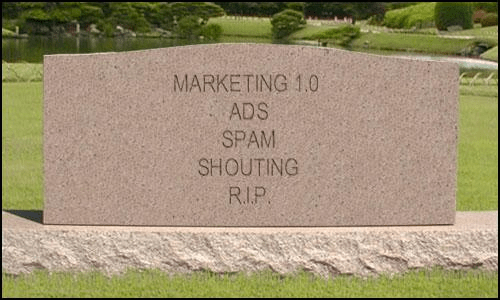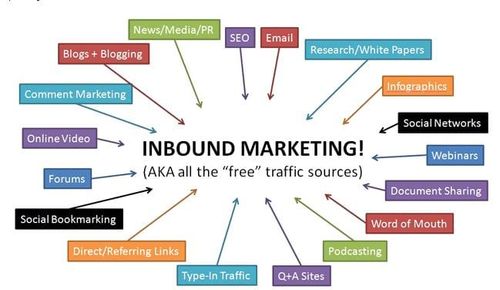Inbound Marketing: Get FREE traffic on your website!
A revolution is occurring in the Marketing’s world! Today consumers are in control. Inbound Marketing is beating up the traditional Marketing methods aka Outbound Marketing. Join the movement!
Outbound Marketing: Game over?

About ten years ago, Marketers mainly used the following methods: telemarketing, e-mail blasting and advertising. Those Outbound Marketing techniques - successful at that time - consisted in pushing a message out. What do they have in common? They are all interruption-based techniques. Worse so: they are intrusive. Therefore consumers found ways to block them. To do so many tools were developed: spam filters, Caller ID or Do Not Call Registry and so on. Advertising can now be avoided when watching a movie or listening to music thanks to the emergence of TiVo/DVRs, video content online, mp3 players… On the contrary Inbound Marketing represents a set of actions to attract consumers to your website using free traffic sources.
So, is Outbound Marketing dead? Not yet. In Europe, marketers still love sending out direct e-mails. 86% continue to use it or plan to do so in 2011. But the use of Outbound Marketing is surely going to decrease in the near future and will progressively be replaced by Inbound Marketing for obvious reasons:
- Efficiency: consumers can now stop those interruptions.
- Costs: leads generated by Inbound Marketing cost 62% less than those generated by Outbound Marketing.
- Trend: where can marketers meet consumers? Inbound Marketing answers this question: Fish where the fish are. Let the consumers find you… But be sure to be at the right places!
OK before going any further, I have to admit that the title of this article is a bit of an exaggeration. The traffic sources used by Inbound Marketing are free but creating and managing them requires work and thus human resources. What is true though is that Outbound Marketing techniques mean recurring costs (each new campaign has to be funded) while Inbound Marketing enables to start a virtuous circle where traffic and lead generation costs are paid off on the long run.

Inbound Marketing… Action!
If you fancy transforming your website into a Marketing Hub, start by positioning yourself at the strategic spots.
Where can you find your consumers? Three magic places:
- blogosphere
- search engines (not to say « Google »)
- social media
To summarize, the purpose of Inbound Marketing is to be found on those three spheres. It enables you to attract Internet users, to maximize inbound links and thus get a better page rank. What is the secret recipe? Create rich, valuable, infectious content.
Step 1: create a blog. You already have one? Sure you do. But do you publish anything else than articles? Written by your staff? Do you have videos, podcasts, comics or any other form of content? Talking about content… Do you often publish experts’ interviews? Consumers’ feedback? Diversity is good!
Step 2: improve your SEO and do not only focus on SEM. Spend some time on improving your website general organization, page titles (keywords at the beginning, not at the end), page content, URL names and so on.
Google is fighting Black Hat SEO (Fear the Panda!) and Inbound Marketing is going in the same direction by emphasizing quality content and legitimacy.
Step 3: adapt your content to the right social media. For example, create a fun Facebook page, a LinkedIn Group about an important stake for your business, answer questions on Quora, try to get a first position on Digg or StumbleUpon.
Step 4: create a network. This can sound pretty lame but many of us do not spend enough time and energy doing this right. You can start off by spotting the most influent blogs in your industry. Then interact with them by commenting their articles and when it is appropriate mention your own blog: “We also had a passionate debate on this topic, see this article”. Being active on influent blogs will help you gain both visibility and authority. This is good as Google ranks you based on relevance and authority.
Some figures to conclude
In France, Inbound Marketing is not yet a really famous topic but in the US a book has already been written about it: Inbound Marketing. The authors’ blog is full of rich content - of course - and of interesting figures. Here are some convincing ones:
- 57% of businesses have acquired a customer through their company blog.
- 41% of B2B companies and 67% of B2C companies have acquired a customer through Facebook.
- The number of marketers who say Facebook is “critical” or “important” to their business has increased 83% in just 2 years.
- Companies that blog get 55% more web traffic. The more you blog, the more pages Google has to index, and the more inbound links you're likely to have. The more pages and inbound links you have, the higher you rank on search engines like Google—thus the greater amount of traffic to your website. Which is why we repeat: Blogging is good.
Those figures reveal, among other things, that Inbound Marketing enables to increase traffic but more so: to acquire consumers. To be honest… That’s the point. Using efficient call to action buttons can increase your conversion rate from 0.5% with a lame one (like “Contact us” without a form to fill in) to 5% with an efficient one like a webinar, a white paper or a free trial. (Those figures come from Inbound Marketing, Chapter 8).
Like for all Marketing actions Inbound Marketing’s success will be determined using analytics. Know the famous quote from Edwards Deming?
In God we trust; all others must bring data.
The final step then is to choose the right metrics, analyze and… be delighted with the results!
